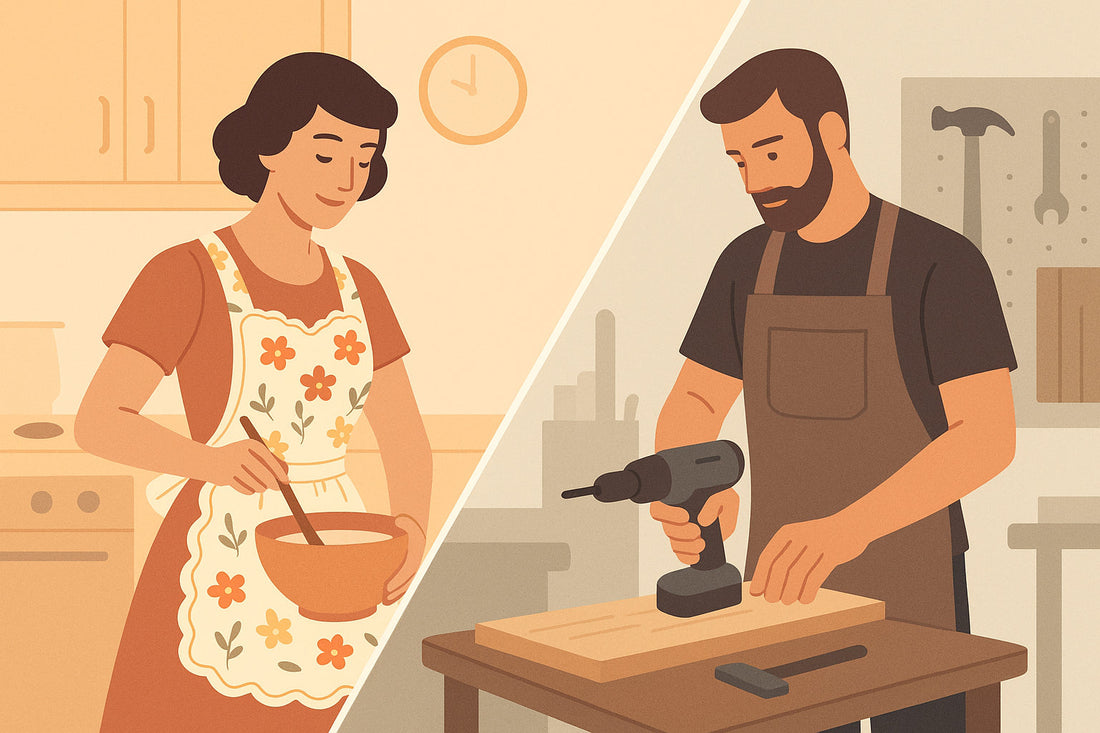
Gender Roles in Aprons: History vs. Today
Share
Aprons have evolved from being symbols of traditional domestic roles to practical, gender-neutral tools used by everyone. Here's a quick look at the key points:
- Historical Role: Aprons were primarily associated with women in homemaking, symbolizing domestic responsibilities and societal expectations.
- Modern Shift: Aprons now prioritize function over form, with designs featuring adjustable straps, durable fabrics, and neutral colors for all genders.
- Professional Use: Today, aprons are essential in professional kitchens, workshops, and creative spaces, reflecting skill and expertise rather than gender roles.
- Market Trends: Companies like Hedley & Bennett reported a 30% increase in male buyers for their aprons in 2024, showcasing a shift toward inclusivity.
Quick Comparison:
| Aspect | Past (Pre-1970s) | Present (2025) |
|---|---|---|
| Primary Users | Mostly women in domestic roles | All genders in various settings |
| Design Focus | Feminine, decorative | Neutral, functional |
| Purpose | Homemaking | Professional and creative tasks |
| Features | Basic coverage, simple pockets | Adjustable straps, extra storage |
| Materials | Lightweight, decorative fabrics | Heavy-duty, durable fabrics |
This transformation shows how aprons have shifted from being tied to traditional gender roles to becoming versatile, inclusive workwear for all.
The Apron Manifesto: What if one garment could change your ...
Aprons in History
Aprons have transformed over time, shifting from simple protective gear to powerful symbols that reflect changes in domestic and gender roles. Let’s explore their evolution through their early purpose, connection to domestic life, and complex symbolism.
Early Uses and Function
Initially, aprons served a practical purpose: protecting clothing during work. By the 1700s, they began to symbolize responsibility within the home.
Women’s Role in Domestic Life
In the 1800s, aprons became closely tied to women’s roles in the household. They represented the skills and expertise needed to manage a home. However, they also highlighted the societal expectations placed on women, both respecting their knowledge and confining them to specific roles.
A Dual Symbol
The apron carried mixed messages. While it celebrated domestic skill and care, it also reinforced restrictive ideas about gender and a woman’s place in society.
Gender Roles and Apron Types
Men's vs. Women's Aprons
In the past, aprons were designed to align with traditional professional and domestic roles, often reflecting societal expectations tied to gender. This historical approach laid the groundwork for the shift in apron design that emerged after the 1970s.
Changes Since the 1970s
Apron designs have come a long way since the 1970s, focusing more on practicality and universal appeal rather than gender-specific styles. A great example is Hedley & Bennett's January 2024 launch of an adjustable, size-inclusive apron collection, which led to a 30% increase in Q1 sales.
Modern aprons now include features such as:
- Adjustable straps for a personalized fit
- Multiple pockets to hold tools and accessories
- Durable, heavy-duty fabrics
- Neutral colors and patterns suitable for everyone
- Professional-grade craftsmanship
With prices ranging from $26.00 to $28.00, these aprons are designed to handle a variety of tasks, from cooking and grilling to crafting.
sbb-itb-c693c43
Current Apron Design Trends
Gender-Neutral Features
Today's apron designs focus on inclusivity and practicality, moving away from gender-specific looks. These aprons are made to fit all body types and include features like:
- Adjustable straps for a personalized fit
- Neutral colors like black that suit any style
- Durable fabrics to handle a variety of kitchen tasks
This shift prioritizes function and accessibility, offering options that work for everyone.
Modern Apron Options
Current apron options highlight practicality over traditional gender roles. Take, for instance, Cosmic Aprons' Professional Grade Chef and Kitchen Apron with Pockets, available for $26.00. It combines a neutral design with useful features like multiple storage pockets.
Their heavy-duty BBQ apron, priced at $28.00, includes:
- Strategically placed pockets for easy access to tools
- Comfort-focused details for long wear
These aprons cater to a wide audience, allowing buyers to choose based on their needs rather than outdated notions. Expanded size ranges and task-specific designs further showcase how modern aprons are reshaping the kitchen experience.
Past vs. Present Gender Roles
The meaning of aprons has shifted alongside changes in gender roles. Once a symbol tied closely to women’s roles in the home, aprons now represent skill, practicality, and professionalism for people of all genders.
Gender Role Comparison Table
| Aspect | Historical Context (Pre-1970s) | Modern Context (2025) |
|---|---|---|
| Primary Users | Mostly women in domestic roles | All genders across a variety of settings |
| Design Focus | Frills, feminine patterns, decorative | Durability, functionality, neutral designs |
| Purpose | Homemaking and domestic duties | Professional tasks and creative activities |
| Marketing | Geared toward housewives | Inclusive, appealing to a diverse audience |
| Professional Use | Limited to domestic service roles | Essential in culinary, craft, and creative fields |
| Price Range | Inexpensive household items | High-quality options ($26.00-$28.00) |
| Material Choice | Lightweight fabrics with embellishments | Durable, heavy-duty materials |
| Features | Basic coverage, simple pockets | Adjustable straps, extra storage, reinforced stitching |
This comparison highlights how aprons have evolved from being a household accessory into a versatile tool for professionals and hobbyists alike. Vintage aprons were often delicate and decorative, reflecting traditional ideas about femininity. In contrast, today’s designs are built for durability and packed with practical features.
In professional kitchens especially, aprons have become a symbol of expertise rather than domesticity. Whether it’s a heavy-duty BBQ apron or a chef’s apron with multiple storage options, modern designs focus on functionality and performance - proving that cooking and craftsmanship are for everyone.
Conclusion
Aprons have transformed from gendered symbols into practical workwear that reflects changes in society's views on gender roles and workplace expectations. Modern designs focus on practicality and inclusivity, featuring durable fabrics and adjustable elements that suit a wide range of needs and preferences.
This change isn't just about new design features - it's about reimagining the role of aprons in everyday life. Once associated with decorative, gender-specific aesthetics, aprons now prioritize utility. Heavy-duty materials and functional storage options have replaced the frilly, decorative styles of the past.
This evolution challenges traditional gender roles in both domestic and professional spaces. What was once a symbol of women's household responsibilities has become a tool that represents skill, creativity, and professionalism for everyone. Aprons today are designed to support both high-level performance and personal expression, breaking away from their historically gendered image.
Manufacturers are now creating aprons that combine strength and adaptability, catering to a wide audience. As mentioned earlier, these modern designs reflect a broader cultural shift toward inclusivity and skill-focused functionality.
Cosmic Aprons is a great example of this progress. Their carefully designed products embody the journey from outdated stereotypes to high-quality, inclusive workwear for kitchens, workshops, and beyond.
FAQs
How have apron designs and materials evolved to reflect changing gender roles?
Aprons have come a long way from being seen as symbols of traditional gender roles. Historically, they were often associated with women’s domestic responsibilities, but modern designs challenge these stereotypes by embracing inclusivity and functionality for everyone. Today, aprons are made with diverse materials like durable canvas, lightweight cotton, and even leather, ensuring they cater to various needs - from home cooking to professional kitchens and outdoor BBQs.
Modern aprons also feature adjustable straps, practical pockets, and gender-neutral styles, making them suitable for all body types and preferences. These thoughtful updates reflect a shift toward breaking outdated norms and celebrating individuality in both personal and professional spaces.
How have aprons reflected traditional gender roles, and what has changed in modern times?
Historically, aprons were closely tied to traditional gender roles, often seen as symbols of domesticity and typically associated with women in the kitchen. They represented societal expectations of women as caregivers and homemakers.
Today, these perceptions have evolved. Aprons are now designed for everyone, breaking away from outdated stereotypes. Modern aprons feature practical elements like adjustable straps and pockets, making them versatile for all chefs - whether at home or in professional settings - regardless of gender.
What makes modern aprons a must-have for professionals and creatives, and which features enhance their functionality?
Modern aprons have become essential tools for professionals and creatives because they combine practicality with style. Designed to protect clothing while offering convenience, they are perfect for chefs, artists, crafters, and anyone working in hands-on environments.
Key features like adjustable straps ensure a comfortable fit for all body types, while multiple pockets provide easy access to tools and essentials. Whether you need a durable apron for heavy-duty tasks like grilling or a lightweight option for everyday use, modern designs cater to a wide range of needs and preferences.
